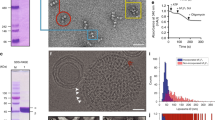Abstract
Single-channel electrophysiological recordings from rat liver mitoplast membranes showed that the 1.3-nS mitochondrial megachannel was activated by Ca++ and inhibited by Mg++, Cyclosporin A, and ADP, probably acting at matrix-side sites. These agents are known to modulate the so-called mitochondrial permeability transition pore (Gunter, T. E., and Pfeiffer, D. R. (1990)Am. J. Physiol. 258, C755–C786) in the same manner. Furthermore, the megachannel is unselective, and the minimum pore size calculated from its conductance is in agreement with independent estimates of the minimum size of the permeabilization pore. The results support the tentative identification of the megachannel with the pore believed to be involved in the permeabilization process.
Similar content being viewed by others
References
Antonenko, Y. N., Kinnally, K. W., Perini, S., and Tedeschi, H. (1991).FEBS Lett. 285, 89–93.
Asimakis, G. K., and Sordhal, L. A. (1981).Am. J. Physiol. 241, H672–H678.
Bernardi, P., Angrilli, A., and Azzone, G. F. (1990).Eur. J. Biochem.,188, 91–97.
Broekemeier, K. M., Dempsey, M. E., and Pfeiffer, D. R. (1989).J. Biol. Chem. 264, 7826–7830.
Crompton, M., and Costi, A. (1988).Eur. J. Biochem. 178, 488–501.
Crompton, M., Ellinger, H., and Costi, A. (1988).Biochem. J. 255, 357–360.
Davidson, A. M., and Halestrap, A. P. (1990).Biochem. J. 268, 147–152.
Fagian, M. M., Pereira da Silva, L., Martins, I. S., and Vercesi, A. E. (1990).J. Biol. Chem. 265, 19955–19960.
Fournier, N., Ducet, G., and Crevat, A. (1987).J. Bioenerg. Biomembr. 19, 297–303.
Garlid, K. D., and Beavis, A. D. (1986).Biochim. Biophys. Acta 853, 187–204.
Gunter, T. E., and Pfeiffer, D. R. (1990).Am. J. Physiol. 258, C755–C786.
Halestrap, A. P., and Davidson, A. M. (1990).Biochem. J. 268, 153–160.
Harris, E. J., Al-Shaikhaly, M., and Baum, H. (1979).Biochem. J. 182, 455–464.
Haworth, R. A., and Hunter, D. R. (1979).Arch. Biochem. Biophys. 195, 460–467.
Haworth, R. A., and Hunter, D. R. (1980).J. Membr. Biol. 54, 231–236.
Hille, B. (1984).Ionic Channels of Excitable Membranes, Sinauer Associates, Sunderland, Massachusetts.
Kinnally, K. W., Campo, M. L., and Tedeschi, H. (1989).J. Bioenerg. Biomembr. 21, 497–506.
Kinnally, K. W., Zorov, D., Antonenko, Y., and Perini, S. (1991).Biochem. Biophys. Res. Commun. 176, 1183–1188.
LaNoue, K. F., Watts, J. A., and Loch, C. D. (1981).Am. J. Physiol. 241, H663–H671.
Massari, S., and Azzone, G. F. (1972).Biochim. Biophys. Acta 283, 23–29.
McCormack, J. G., Halestrap, A. P., and Denton, R. M. (1990).Physiol. Rev. 70, 391–425.
Nicholls, D., and Akermann, K. (1982).Biochim. Biophys. Acta 683, 57–88.
Nicolli, A., Redetti, A., and Bernardi, P. (1991).J. Biol. Chem. 266, 9465–9470.
Novgorodov, S. A., Gudz, T. I., Kushnareva, Y. E., Zorov, D. B., and Kudrjashov, Y. B. (1990).FEBS Lett. 277, 123–126.
Petronilli, V., Szabó, I., and Zoratti, M. (1989).FEBS Lett. 259, 137–143.
Sorgato, M. C., Keller, B. U., and Stuehmer, W. (1987).Nature (London)330, 498–500.
Sorgato, M. C., Moran, O., DePinto V., Keller, B. U., and Stuehmer, W. (1989).J. Bioenerg. Biomembr. 21, 485–496.
Szabó, I., and Zoratti, M. (1991).J. Biol. Chem. 266, 3376–3379.
Zoratti, M., and Szabó, I. (1991). InTrends in Biomembranes and Bioenergetics (Menon, J. ed.), Compilers International, Trivandrum, India, pp. 263–329.
Author information
Authors and Affiliations
Additional information
Abbreviations used: PT: permeability transition; PTP: permeability transition pore; MMC: mitochondrial megachannel; IMAC: inner membrane anion channel. PA: permeability of ion A. CSP: Cyclosporin A.
Rights and permissions
About this article
Cite this article
Szabó, I., Zoratti, M. The mitochondrial megachannel is the permeability transition pore. J Bioenerg Biomembr 24, 111–117 (1992). https://doi.org/10.1007/BF00769537
Issue Date:
DOI: https://doi.org/10.1007/BF00769537




